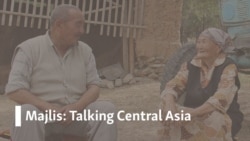
When it comes to energy pipelines in Central Asia, the news is usually bad -- delays or disruptions but rarely anything positive.
That's why the reports this week that Tajikistan was constructing its part of the Turkmenistan-China gas pipeline was very welcome news on a project that had often been moribund.
Tajik Deputy Energy Minister Sharif Hudobakhsh spoke about progress in building the Tajik section of line D, the gas pipeline that eventually will run from the gas fields of eastern Turkmenistan into western China.
It is very good news for the Turkmen government that has been pushing a pipeline project through Afghanistan that might never be realized and expressing half-hearted interest in construction of the Trans-Caspian gas pipeline project, which also might never be built.
Even line D is several years, at least, away from starting operation, but according to Hudobakhsh, work on it is moving forward -- at least in his country.
Hudobakhsh said the first tunnel for the pipeline is 99.8 percent completed. He also said the project was expected to be finished "on time," though he did not say when that would be.
Originally the plan was to have the Tajik section done by the end of 2020, but Tajikistan only resumed work on the pipeline in 2018 and construction appears to still be happening only in Tajikistan’s western Rudaki region, which borders Uzbekistan.
As a report from RFE/RL’s Tajik Service, known locally as Ozodi, noted, 47 tunnels need to be built along the approximately 400-kilometer route. From there the route goes into the mountains to remote and sparsely inhabited areas of eastern Tajikistan.
The state company Tajiktransgaz is teaming up with China’s Trans-Asia Gas Pipeline Co, a subsidiary of the China National Petroleum Corporation (CNPC), to build and operate the pipeline.
Tajikistan will not receive any of the gas from the pipeline.
But the joint Tajik-Chinese company expects to see some $15 billion in profits over the course of 32 years, some $1.2 billion of which the Tajik government expects to take in as taxes, and some $2.5 billion from stock dividends.
Turkmenistan: In Need Of Cash
Turkmenistan desperately needs money and China is the only customer of any significance.
Russia suspended its supplies of Turkmen gas in 2016, then reached a deal in mid-2019 to import a modest 5.5 billion cubic meters (bcm) of Turkmen gas annually.
Turkmenistan suspended shipments to Iran at the beginning of 2017, over what Ashgabat claimed were unpaid bills from a decade earlier.
And Turkmenistan is still repaying billions of dollars in loans received by China to develop the gas fields and build the pipelines to carry Turkmen gas to China. Beijing deducts an unspecified amount of that bill from the Turkmen gas that it receives.
Line D is the only line of the four (A, B, C) that will carry Turkmen gas exclusively, some 30 bcm. Lines A and B can each carry some 15 bcm of gas per year, and line C can ship some 25 bcm, but since those lines cross Uzbekistan and Kazakhstan, both those countries can pump some 10 bcm each into the network, leaving 35 bcm of gas for Turkmenistan.
But while the news from Tajikistan offers a ray of hope for the cash-strapped Turkmen government, the situation regarding pipeline construction in Uzbekistan and Kyrgyzstan is unclear.
Uzbekistan said in early 2017 it was suspending construction of its section of line D and so far has not signaled that work has resumed.
Kyrgyzstan was supposed to start construction of its 215-kilometer section in December 2019, but one month before that, Prime Minister Muhkhammedkalyi Abylgaziev said his country wanted to review the contract it has with China for construction of line D.
There were no reports of work having started on the Kyrgyz section of line D in December, as planned.
Like Tajikistan, Kyrgyzstan also will not receive any gas from the pipeline but is counting on transit fees and taxes to provide some extra revenue.
Of course, both Kyrgyzstan and Tajikistan owe China money, so there is no certainty that Beijing will not want to arrange a payment scheme similar to what it worked out with Turkmenistan. That would certainly take a bite out of some of the revenue Bishkek and Dushanbe are expecting.
But all these matters are for what promises to be very complicated negotiations in the future.
For now, line D is moving into Tajikistan.
One tunnel has been constructed, just 46 to go and some 360 kilometers until the pipeline reaches the Kyrgyz border.
The official launch date is still 2022.









